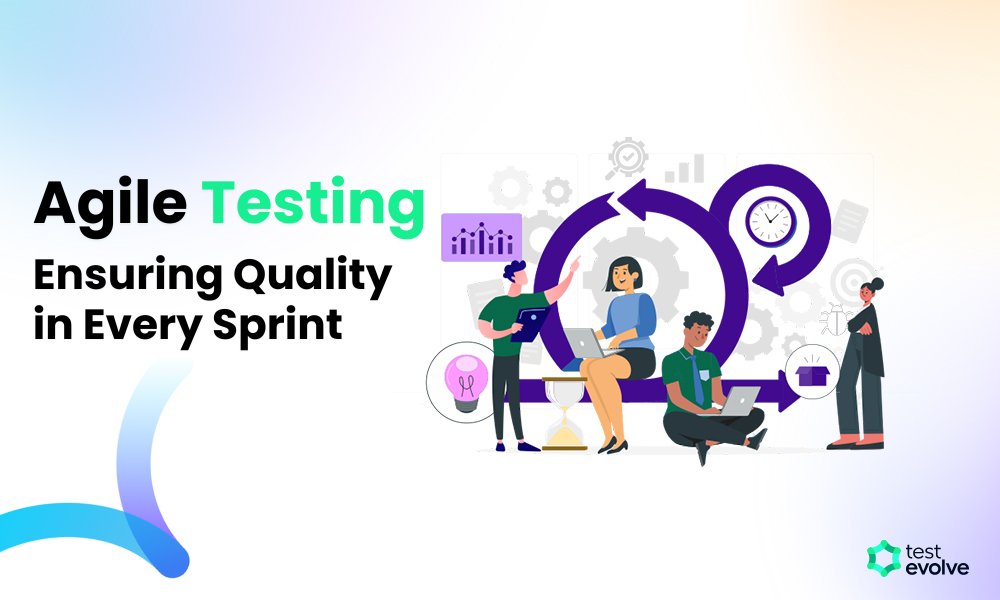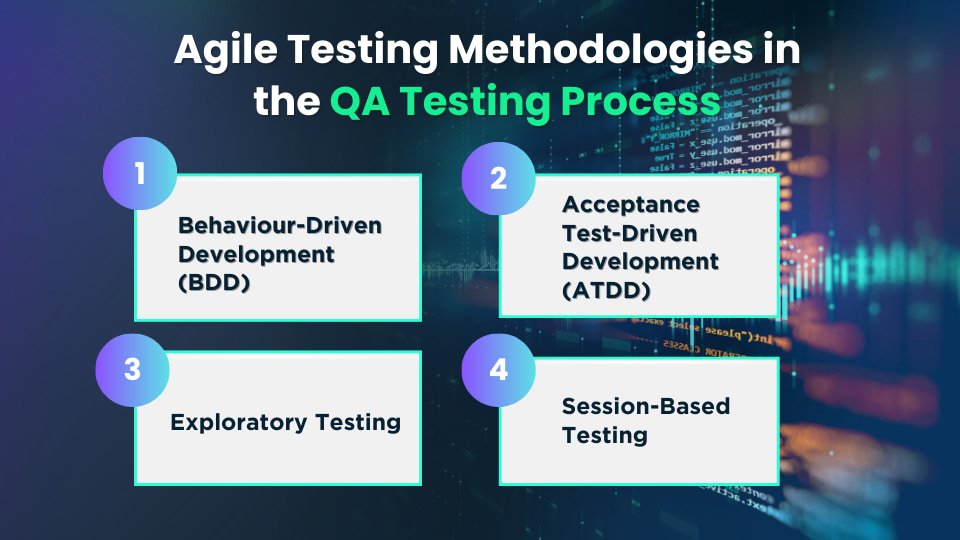Agile Testing: Ensuring Quality in Every Sprint
Testing in Agile is all about adaptability. QA teams increasingly find themselves out of sync because of extensive development cycles and short turnarounds. The idea is to include testing as a process in every sprint, enabling early issue detection and stronger collaboration between development and QA.
This approach is not only aimed at identifying the presence of bugs. It is about making testing effective, improving the software features continually, and ensuring that the software meets the client’s needs.
In this article, we will discuss Agile testing from a QA perspective, examining how it reshapes workflows and equips teams to meet deadlines.
What does Agile mean within the QA context?
Agile QA is a dynamic, iterative approach where testing evolves alongside development. Unlike traditional methods that treat testing as a final checkpoint, Agile testing integrates quality assurance into every phase, starting from the initial design and continuing until stabilisation.
Testers work closely with developers in Agile to ensure critical features are tested first. Instead of trying to test everything. The emphasis is on the most important user stories with the biggest impact. This helps catch issues early and keeps the team aligned on priorities.
Automation tools play a pivotal role, enabling faster execution and broader coverage, while lessons from previous cycles drive continuous refinement. The Agile QA process is more than just defect detection. It’s a strategy to deliver reliable, user-focused software within tight timelines.
Continuous feedback from past projects plays a big role in improving the process and helping teams deliver better software, sprint after sprint.
By adopting the Agile QA process, teams can minimize risks, streamline workflows, and consistently improve software quality..
Benefits of implementing an Agile QA process
Agile testing is a very important part of the SDLC. It plays an important role in product quality improvement, accelerating the software release cycle. By allowing for continuous feedback and testing throughout the testing phases, an agile methodology ensures that defects are identified and addressed early, reducing the risk of late-stage bugs, missed deadlines and bug leaks.
In Agile, good test case management helps the QA team prioritize essential features and provide maximum valuation in each iteration. The flexible form of testing in this sprint makes customers more satisfied with the release because it prioritizes important functions of the tool and influences retention and loyalty.
Best Agile QA Practices
Agile QA is a collaborative testing approach that embeds quality assurance into every stage of development. Here are the key practices to ensure effective Agile QA practices:
1. Risk Analysis
In an Agile environment, understanding and managing risks early is vital to delivering a robust product. Identifying risks such as integration issues, security vulnerabilities, or performance bottlenecks allows teams to address potential problems before they escalate.
For instance, in a project to launch a new social media feature, QA teams might identify the risk of latency in real-time updates. By testing for network delays in earlier sprints, teams can resolve these issues early, ensuring a smoother user experience when the feature is live.
While achieving a high-quality product is attainable, prioritising and mitigating critical risks helps create a more reliable and stable final product.
2. Test Early, Test Often
Agile emphasizes continuous testing as a core principle. QA should be involved from the very first sprint and maintain a regular testing schedule throughout the development process.
For example, in a financial mobile app, a QA team tests newly implemented features, such as in-app payments, during each sprint to catch bugs early.
This frequent testing helps identify issues such as UI inconsistencies or broken links well before they reach the user.
Early and frequent testing also allows teams to integrate new features smoothly without disrupting existing functionality, reducing delays and improving the speed of delivery.
3. Automate Where it Adds Value
Automation can streamline regression testing and reduce manual workloads. However, it is important to focus on automating high-priority test cases to avoid false positives and wasted resources.
For instance, a large e-commerce platform might automate tests for payment gateways or checkout flows, which are critical to the business.
Although setting up automated tests may take time and resources upfront, the long-term advantages include faster feedback loops, fewer manual errors, and more time for exploratory testing.
Automation allows QA teams to run tests quickly across multiple browsers and devices, ensuring consistent quality throughout each sprint.
4. Understand Your Audience
Understanding the target audience is a cornerstone of Agile QA. A successful QA strategy aligns testing priorities with end-user expectations, ensuring each feature meets real-world needs.
Tools like Test Evolve enable this alignment by providing features such as behaviour-driven development (BDD) test recorders and real-time dashboards. These capabilities allow teams to efficiently simulate and validate workflows, like task tracking in a project management SaaS, ensuring the product is user-centric and functional.
By integrating tools that focus on user workflows, Agile QA teams can deliver applications that not only meet functional requirements but also provide a seamless user experience.
5. Foster QA Team Collaboration
In Agile, quality is everyone’s responsibility, not just the QA team’s. Collaboration between developers, testers, and stakeholders ensures the product meets both technical and business goals.
For example, a development team working on a new cloud storage app may need QA to collaborate with developers on feature integration like file syncing.
QA testers can help identify edge cases or compatibility issues that developers may miss. Continuous interaction between team members ensures that issues are identified early and solutions are implemented quickly. This collaborative approach helps to maintain a high standard of quality while minimising delays.
6. Open Communication and Feedback
A culture of open communication and regular feedback is essential for the continuous improvement of the product.
QA teams should hold regular sprint demos and retrospectives to gather feedback from developers and stakeholders. After each sprint, the team might review testing results and highlight any blockers that affected progress. This transparency builds trust and ensures everyone is aligned on the project’s goals.
Additionally, it encourages a solutions-orientated mindset, where issues are addressed collaboratively and improvements are made in real time. This approach helps teams adapt to changes quickly, fostering a culture of constant learning.
7. Shared Ownership and Accountability
Agile methodology thrives on shared ownership and collective responsibility. In a well-functioning Agile team, each member is responsible for the project’s success, not just their individual tasks.
Let’s say for a mobile app development project, developers, designers, and QA testers all have a hand in ensuring the app performs optimally. This collective accountability means that everyone from developers writing code to QA running tests works toward the same outcome, delivering a high-quality product.
This shared ownership and accountability promotes a strong sense of commitment to achieving team goals, improving overall morale and the quality of the final product.
8. Plan and Test User Stories
User stories are the foundation of Agile development, and testing each user story thoroughly is essential. By estimating the necessary testing effort for each user story early on, teams can plan testing strategies that align with business objectives.
If a user story is focused on improving user authentication, QA would prioritize test cases around security, usability, and load testing. This targeted approach ensures that each feature is adequately tested before it moves to production.
In dynamic environments, user stories may evolve, and QA teams should be flexible, adapting their tests as stories change or new acceptance criteria are introduced.
9. Focus on end-users and Adapt to Change.
The ultimate goal of Agile QA is to deliver value to the end-user. This requires QA teams to prioritize features that directly impact user experiences, such as performance, usability, and functionality.
An example of this is a gaming company working on a new multiplayer feature. QA needs to test the game's performance under various load conditions and ensure users can join and play without lags. Agile QA teams must also remain adaptable to changes, whether it's user feedback, market shifts, or new technology.
The ability to quickly pivot and test new features or modifications ensures that the product remains relevant and continues to meet user expectations.
Tools and Technologies Use in Agile QA Testing
Agile QA testing relies on an array of tools and technologies to streamline processes and ensure efficiency.
Test Management Tools: Tools like Jira and Azure DevOps are used to manage test cases, track defects, and monitor results effectively, ensuring seamless collaboration across teams.
Test Automation Tools: Selenium and Appium are popular for automating repetitive test scenarios, reducing manual efforts, and enabling faster test execution.
Continuous Integration/Continuous Delivery (CI/CD) Pipelines: Tools like Jenkins and GitLab CI automate the build, test, and deployment phases, fostering a faster and more reliable development lifecycle.
Real-Time Reporting Tools: Test Evolve’s Halo Dashboards offer robust capabilities for monitoring test execution and outcomes in real-time. These dashboards provide actionable insights that help QA teams address issues promptly, optimize test coverage, and improve decision-making throughout sprints.
By leveraging these tools, Agile QA teams can enhance efficiency, maintain quality, and deliver software that meets user expectations and business goals.
Agile Testing Methodologies in the QA Testing Process
In Agile development, testing is a foundation. Before implementing a user story, it's crucial to define its acceptance criteria, which guide the testing process and ensure the story meets expectations.
Regardless of the specific Agile framework (Scrum, XP, Kanban, or hybrid), these testing methods are commonly employed:
1. Behaviour-Driven Development (BDD)
Behaviour-Driven Development (BDD) is an Agile testing approach aimed at fostering better collaboration between technical and non-technical team members. It defines application behavior in a common language that is easily understood by stakeholders, testers, and developers alike.
The Given-When-Then structure, a cornerstone of BDD, provides a systematic way to describe scenarios. Written in Gherkin syntax, this format not only clarifies requirements but also serves as a foundation for automated testing.
Given-When-Then Structure
This structured approach ensures clarity in defining test scenarios:
Given: Specifies the initial context or preconditions (e.g., "Given the user is logged into their account").
When: Describes the event or action taken (e.g., "When the user clicks on the 'Pay Now' button").
Then: Defines the expected outcome (e.g., "Then the system processes the payment and displays a confirmation message").
Best Practices for BDD Testers
Simplify Documentation: Keep scenario descriptions concise yet precise to prevent misinterpretation or redundancy.
Collaborative Planning: Use the Three Amigos approach (developers, testers, and stakeholders) to define comprehensive, relevant scenarios.
Automate Effectively: Leverage tools like Test Evolve for creating and automating Gherkin-based scenarios, improving both efficiency and test coverage.
Align Scenarios with Business Goals: Focus on user-centric behaviors to ensure that software delivers measurable value.
Tools for BDD
Cucumber: Simplifies the creation of Gherkin scenarios and automates their validation.
Test Evolve: Enhances BDD processes with advanced capabilities such as automated test case generation and real-time reporting. These features streamline collaboration across QA, development, and business teams.
2. Acceptance Test-Driven Development (ATDD)
ATDD (Acceptance Test-Driven Development) focuses on defining acceptance criteria for features before development begins, ensuring alignment between the product and user expectations. It emphasises collaboration between stakeholders, testers, and developers to capture precise requirements through user acceptance tests (UATs).
This methodology ensures that every development cycle is guided by clear, customer-centric criteria. By repeatedly developing and validating the code against these criteria, teams can confidently deliver functionality that meets user needs.
Best Practices for ATDD Testers:
Engage Directly with Customers: Collaborate with end-users and stakeholders to understand their needs and expectations, which helps in crafting meaningful acceptance criteria.
Foster Cross-Functional Collaboration: Involve teams like customer service, sales, and product management to provide a holistic view of customer priorities.
Focus on Customer: Centric Acceptance Criteria: Develop acceptance criteria that align explicitly with user stories and expectations, ensuring a clear path to acceptance.
Prioritise System Validation: Validate functionality iteratively, ensuring features not only work as expected but deliver value to end-users.
Example Application:
In a project for an e-commerce platform, ATDD could involve defining acceptance criteria such as, “Given a logged-in user, when they add a product to the cart and proceed to checkout, then the system should display payment options and a summary of the purchase.” This ensures development meets real-world usage scenarios.
3. Exploratory Testing
Exploratory testing is a dynamic and unscripted approach where testers rely on their expertise and instincts to identify hidden issues. This manual testing method encourages creativity and adaptability, often uncovering defects that formal methods like test-driven development might overlook.
Unlike structured approaches, exploratory testing allows testers to simultaneously learn about the application, design tests, and execute them. It is especially effective in identifying usability issues, edge cases, or unexpected risks.
Best Practices for Exploratory Testers:
Organise Features: Leverage tools like mind maps or spreadsheets to outline application functionality for better structure during exploration.
Track Test Coverage: Ensure comprehensive test coverage by using session management tools. Test Evolve offers real-time dashboards and activity tracking, which enable testers to log and review their exploratory sessions, ensuring no critical areas are missed.
Focus on Risk and Value: Prioritise high-risk areas or functionalities that deliver maximum user value, concentrating efforts where they matter most.
Document Findings: Maintain clear and concise records of issues discovered, steps taken, and potential improvements for accountability and reference in future testing cycles.
Pair Testing: Collaborate with other team members during testing sessions to gather diverse perspectives and enhance test outcomes.
4. Session-Based Testing
Session-based testing blends the flexibility of exploratory testing with a structured framework. In this approach, each session has a predefined objective, known as a "charter," which focuses on a specific area or functionality. This method is ideal for uncovering defects that might not surface in conventional test cases.
While testers have the choice to adapt their approach during the session, they are required to document their findings comprehensively, ensuring traceability and accountability. This structured yet adaptable method is particularly effective in scenarios where time is limited or the system is complex.
Best Practices for Session-Based Testers:
Define Clear Objectives: Establish charters with focused goals, such as testing a new feature or validating edge cases.
Time Management: Allocate fixed time slots for each session to maintain focus and productivity. Test Evolve's time-tracking capabilities help testers monitor and optimize session durations.
Review Outcomes: Regularly discuss session outcomes with team members to identify gaps and refine future charters.
Prioritise Risk Areas: Focus sessions on high-priority or high-risk areas to maximize testing impact.
Looking for a Transition to Agile Testing
Choosing the right tool for agile QA testing is crucial for the success of the automation process.
For agility, Test Evolve offers an easy-to-adopt toolset that seamlessly integrates into your processes for planning, prioritization, and assessment. This enables teams to maintain a fast pace of testing while increasingly showcasing the effectiveness of tests among developers, integrated QA engineers, and other stakeholders.
This Agile Test Automation solution has capabilities, test coverage, traceability, and reporting that make it easy for a team to evaluate the quality of every feature and know when the specific releases are ready for deployment.
For agile testers, Test Evolve has been specifically designed to help you simplify and enhance the quality of your releases.
The one-stop solution for fast and effective automated agile testing for desktop, mobile, and API.



